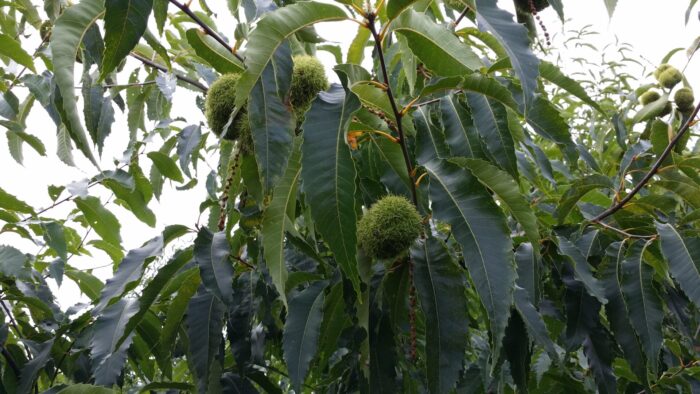Description
Sorry, we can not ship to CA, WA, OR, UT, AK, HI, or Canada.
Hardiness Zones: 4-8
Common Names: American Chestnut
Mature Size: In the absence of blight, this tree can grow 50-75 feet (15-23 meters) tall, sometimes exceeding 100 feet (30 meters). It has a rounded crown that spreads widely with massive branches (Missouri Botanical Garden).
Soil and Climate Requirements: American Chestnuts prefer moderately acidic, sandy loam soil and thrive in sunny, well-drained locations. Morning sun exposure is preferable to afternoon sun, which can lead to bark cracking in winter due to rapid temperature changes. Plantings below 2,500 feet altitude currently have better chances of survival. To minimize frost damage, plant in elevated areas on sloping terrain, avoiding low-lying frost pockets, wet spots, and soils high in limestone or heavy clay.
Notes: Castanea dentata is the true native American Chestnut and lacks resistance to blight. Its leaves are oblong, measuring 6-10 inches (15-25 cm) in length, with toothed edges. In autumn, the leaves turn various shades of yellow. Male flowers are yellowish-white and grow in clusters on catkins measuring 4-8 inches (10-20 cm) long. Female flowers are smaller and less showy. Both male and female flowers bloom in early summer (around June). The fruit is a large nut covered in spiky burrs, approximately 2-3 inches (5-8 cm) wide. Each husk contains 2-3 brown nuts, each ½-1 inch (1-3 cm) wide, maturing in the fall and known for their edible sweetness (Missouri Botanical Garden). When young, the bark is smooth and chestnut brown, developing furrows as the tree matures. Bark of blight-infested trees typically splits open with orange fungus growth (Virginia Tech). American Chestnut trees are best suited for parks or forested areas and historically were prized for their decay-resistant wood rich in tannins, used extensively in furniture making. The species is now nearly extinct in the wild due to chestnut blight.
Wildlife Value: American Chestnut was crucial for wildlife, providing essential autumn mast for species such as White-tailed Deer, Wild Turkey, and formerly, the Passenger Pigeon. Black Bears also relied on the nuts to fatten up for winter.
Potential Issues: Major challenges include chestnut blight, along with susceptibility to powdery mildew, leaf spots, and anthracnose (Missouri Botanical Garden).
For more information, visit:
- Virginia Tech Dendrology: [link]
- Missouri Botanical Garden: [link]










Samantha Doster –
Everyone I’ve purchased has survived and is thriving. So far so good.
TED HAREN –
Excellent quality. Every one I bought has survived their first full year in my yard and are all doing great.
Mark Teggi –
I bought these trees a year ago and all of them are doing wonderfully. I will be buying more for the 2023 planting season!
George Devol –
I bought two about 12+ years ago. Both are doing very well. One is larger about 12′-14′ tall. No nuts as yet. No signs of any disease (cross my fingers)
mike west Order Date 12/5/2008 Invoice # 15751 –
I bought 6 in 2008 from cold stream farms, 1 died, i had to cut 2 down and 3 lived and are still thriving blight free so far, August, 2024. Unfortunately they are too close to a building and I’m going to have to cut them down before they get too big to keep from endangering it. Going to try to top them so they will not die.